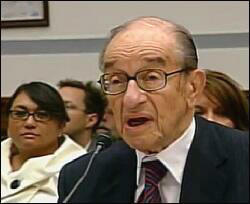Courtesy of Pam Martens.

Alan Greenspan, Former Fed Chairman, Testifying to the House Oversight Committee on How He Got It Wrong, October 23, 2008
There is growing unease in stock and bond markets around the world that the current Chair of the U.S. Federal Reserve, Janet Yellen, has retrieved former Fed Chair Alan Greenspan’s blinders out of the mothballs in some musty old closet at the Fed, thus setting the U.S. economy up for more epic convulsions.
Yesterday, the Federal Open Market Committee (FOMC) released its policy statement and rattled markets here and abroad overnight. The statement contained a number of economic absurdities. The first sentence argued that “economic activity has been expanding at a solid pace” while a few sentences later we are told “inflation has declined further below the Committee’s longer-run objective.” A solid expansion simply does not correlate with declining inflation in the U.S. and mushrooming deflation among our trading partners.
Later in the statement the Fed tells us that inflation will be heading back toward the goal of 2 percent once “the transitory effects of lower energy prices and other factors dissipate.” There is no evidentiary basis offered to support the idea that the historic collapse in oil prices will be “transitory.” The “other factors” remain vague because to enumerate the other factors – slack demand around the globe creating a monster surplus of supply – would destroy the argument that the oil price collapse will be transitory. (And remember, it’s not just energy prices that are swooning, it’s a broad range of industrial commodities which the Fed conveniently fails to mention.)
Bond markets around the world, including the U.S. Treasury market, think Yellen is full of it. Shortly after the FOMC statement was released, the 30-year Treasury hit an historic record low yield of 2.295 percent. The yield on our longest dated Treasury bond reflects two elements: the long-range outlook for inflation and a perceived safe-haven to weather a looming economic upheaval.
Yesterday, the yield on the 30-year Treasury also represented one more thing: a no confidence vote that the U.S. Fed knows how to read the global tea leaves.
…



